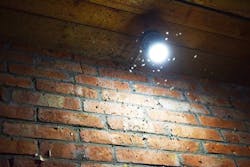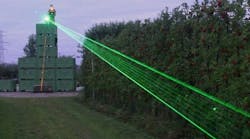LED lights attract fewer insects—especially biting ones
University of Bristol (Bristol, England) scientists have revealed that domestic LED lights are much less attractive to nuisance insects such as biting midges than traditional filament lamps. The team now highlights the urgent need for further research on other heat-seeking flies that transmit disease, including mosquitoes that are carriers of pathogens that cause damaging diseases such as malaria and Zika fever.
Related Article
The study, funded by the Natural Environment Research Council and UK lighting manufacturer Integral LED, used customized traps at 18 field test sites across southwest England, illuminated by a series of LED, filament, and fluorescent light sources. Over 4,000 insects were carefully identified. The results showed that LEDs attracted four times fewer insects compared with the traditional incandescent lamps, and half as many as were attracted to a compact fluorescent lamp.
Notably, for biting flies (midges in the genus Culicoides, some species of which are vectors of wildlife disease), 80% were attracted to the filament lamp, 15% to the compact fluorescent, and only 2-3% to each of the two different LED lamps.
Andy Wakefield led the field research in a project supervised by professors Gareth Jones and Stephen Harris from the University’s School of Biological Sciences. Wakefield said, "We were surprised by the number of biting flies drawn to the traditional tungsten lights. We do not know why this is but we know that some insects use thermal cues to find warm-blooded hosts in the night, so perhaps they were attracted to the heat given off by the filament bulb."
Co-sponsors of the study, Integral LED, were instrumental in the commissioning of the project and provided technical and financial support. The UK company's marketing director Sanjiv Kotecha said, "As lighting manufacturers, we welcome that a link between LED lights and low attraction to insects has been proven. The energy saving advantages of solid-state lighting are well known, yet the benefits to well-being are only beginning to be revealed."
The paper appears in Ecology and Evolution.
SOURCE: University of Bristol; http://www.bristol.ac.uk/news/2016/november/flies-led-lights.html
About the Author

Gail Overton
Senior Editor (2004-2020)
Gail has more than 30 years of engineering, marketing, product management, and editorial experience in the photonics and optical communications industry. Before joining the staff at Laser Focus World in 2004, she held many product management and product marketing roles in the fiber-optics industry, most notably at Hughes (El Segundo, CA), GTE Labs (Waltham, MA), Corning (Corning, NY), Photon Kinetics (Beaverton, OR), and Newport Corporation (Irvine, CA). During her marketing career, Gail published articles in WDM Solutions and Sensors magazine and traveled internationally to conduct product and sales training. Gail received her BS degree in physics, with an emphasis in optics, from San Diego State University in San Diego, CA in May 1986.

